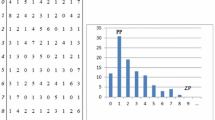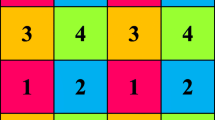Abstract
In this paper, a reversible data hiding scheme is proposed based on histogram shifting of n-bit planes (nBPs). This scheme extracts nBPs from an 8-bit plane for each pixel to generate the bit plane truncation image (BPTI), and then block division is used in the BPTI. These operations can make the peak point of the block histogram more concentrated and improve the probability of the zero point in the block histogram. The histogram shifting method was used to embed secret bits into the peak point in each block. Note that this block was not utilized to embed secret bits if the zero point of a certain block did not exist, thus, there was no overflow or underflow in our scheme when the histogram was shifted. Our proposed scheme achieved higher hiding capacity than previous histogram-based schemes, and its visual quality was very satisfactory. The experimental results validated the expected merits of the proposed scheme.











Similar content being viewed by others
References
Alattar AM (2004) Reversible watermark using the difference expansion of a generalized integer transform. IEEE Trans Image Process 13(8):1147–1156
Chan CK, Cheng LM (2004) Hiding data in images by simple LSB substitution. Pattern Recogn 37(3):469–474
Goljan M, Fridrich JJ, Du R (2001) Distortion-free data embedding for images. Information Hiding. Springer Berlin Heidelberg, 27–41
Hamid N, Yahya A, Ahmad RB et al (2012) Image steganography techniques: an overview. Int J Comput Sci Secur (IJCSS) 6(3):168–187
Hong W, Chen TS, Shiu CW (2009) Reversible data hiding for high quality images using modification of prediction errors. J Syst Softw 82(11):1833–1842
Honsinger CW, Jones PW, Rabbani M et al. (2001) Lossless recovery of an original image containing embedded data. U.S. Patent No.6278791
Huang HC, Chang FC (2013) Hierarchy-based reversible data hiding. Expert Syst Appl 40(1):34–43
Huang HC, Fang WC (2011) Authenticity preservation with histogram-based reversible data hiding and quadtree concepts. Sensors 11(10):9717–9731
Hwang JH, Kim JW, Choi JU (2006) A reversible watermarking based on histogram shifting. Digital Watermarking. Springer Berlin Heidelberg, 348–361
Kim KS, Lee MJ, Lee HY et al (2009) Reversible data hiding exploiting spatial correlation between sub-sampled images. Pattern Recogn 42(11):3083–3096
Kuo WC, Jiang DJ, Huang YC (2008) A reversible data hiding scheme based on block division. CISP’08 Congr IEEE Image Signal Process 1:365–369
Lee CF, Chang CC, Pai PY et al. (2015) An adjustable and reversible data hiding method based on multiple-base notational system without location map. J Digit Imaging
Lee CF, Chen HL, Tso HK (2010) Embedding capacity raising in reversible data hiding based on prediction of difference expansion. J Syst Softw 83(10):1864–1872
Li X, Li B, Yang B et al (2013) General framework to histogram-shifting-based reversible data hiding. IEEE Trans Image Process Publ IEEE Signal Process Soc 22(6):2181–2191
Lin CC, Liu XL, Tai WL et al. (2013) A novel reversible data hiding scheme based on AMBTC compression technique. Multimedia Tools Appl 1–20
Luo H, Yu FX, Chen H et al (2011) Reversible data hiding based on block median preservation. Inf Sci 181(2):308–328
Mali SN, Patil PM, Jalnekar RM (2012) Robust and secured image-adaptive data hiding. Digit Signal Process 22(2):314–323
Ni Z, Shi YQ, Ansari N et al (2006) Reversible data hiding. IEEE Trans Circ Syst Video Technol 16(3):354–362
Qin C, Chang CC, Chen YC (2013) Efficient reversible data hiding for VQ-compressed images based on index mapping mechanism. Signal Process 93(9):2687–2695
Tai WL, Yeh CM, Chang CC (2009) Reversible data hiding based on histogram modification of pixel differences. IEEE Trans Circ Syst Video Technol 19(6):906–910
Tian J (2003) Reversible data embedding using a difference expansion. IEEE Trans Circ Syst Video Technol 13(8):890–896
Zhao P, Li S, Zhou L, Li L, Guo X (2015) Detecting affine-distorted duplicated regions in images by color histograms. J Inf Hiding Multimed Signal Process 1(6):163–174
Acknowledgments
This work was supported in part by NNFSC (No.61272262), Shanxi NSF (No.2012011014-3), YSTRF of TYUST (No.20123004).
Author information
Authors and Affiliations
Corresponding author
Rights and permissions
About this article
Cite this article
Liu, L., Chang, CC. & Wang, A. Reversible data hiding scheme based on histogram shifting of n-bit planes. Multimed Tools Appl 75, 11311–11326 (2016). https://doi.org/10.1007/s11042-015-2855-3
Received:
Revised:
Accepted:
Published:
Issue Date:
DOI: https://doi.org/10.1007/s11042-015-2855-3




